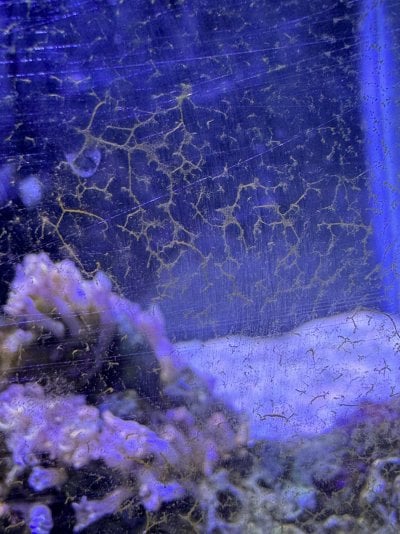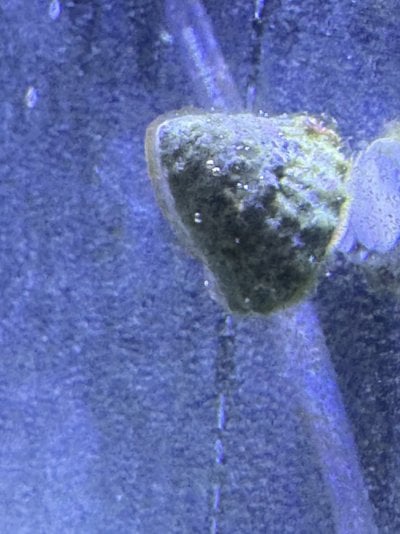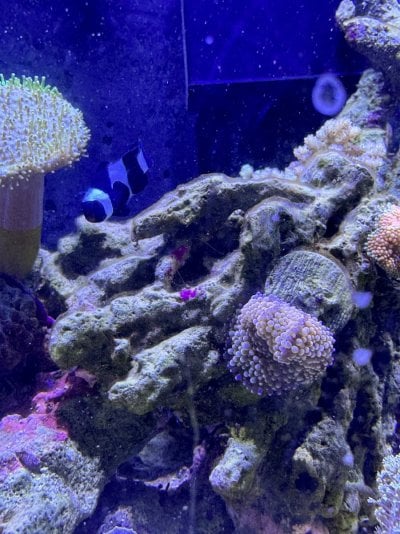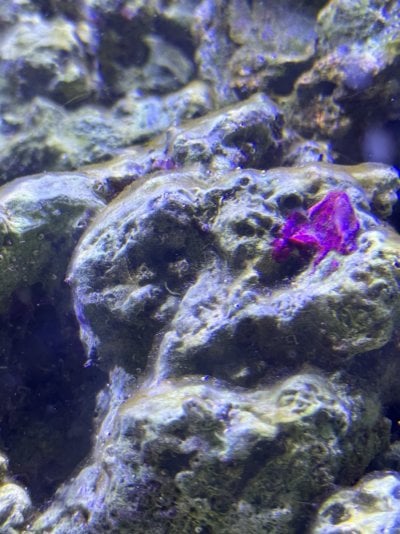Hello all,
About 3 month ago I purchased Chaeto with what appeared to be dinos with brown strings on it and starting dosing Chaetogro which has great results. I tried my best to manually remove all the stringy stuff on the Chaeto but it appears not to have helped as it’s moved to my DT. I have definitely learned my lesson lol. Around this time I also received a rock from a LFS with bubble algae on it that hasn’t really spread much yet but I am working on manually removing it. For about 3 weeks, this brown film has been covering my rocks and some of my corals. There has also been stringy-ness coupled with it on a few spots that look like hair algae. Right now there are small bubbles on top of the film. Attached are some pictures of it including the growth on my glass.
After noticing the problem escalate 2 weeks ago, I lowered my refugium lighting to 12 hours instead of 16 and stopped my weekly 15 percent water changes since I read to increase nutrients. Since then the problem seems to have been slowly increasing or having no effect. Should I stop my skimmer or do anything with my filter socks? I plan on buying a UV light and some Seachem phyto but does anyone have advice for me? My system is overall high nutrient which is why I have been aggressive with my Chaeto nutrient removal, along with trying to increase my coral growth which has been slow for the 1 year I’ve had the system. I also have been struggling with vermetid snails as you might see in my pics so I was trying to feed a bit less the past few months. I’ve never dealt with dinos and mainly only dealt with high nutrient/po4 algae. Any ideas on the species of dinoflagellates or if it’s something else? As of now there is nothing on my sand.
Any help is greatly appreciated!!
Nitrate-6
Nitrite-0
Ammonia-0
Alkalinity- 8.5
Salinity- 1.026




About 3 month ago I purchased Chaeto with what appeared to be dinos with brown strings on it and starting dosing Chaetogro which has great results. I tried my best to manually remove all the stringy stuff on the Chaeto but it appears not to have helped as it’s moved to my DT. I have definitely learned my lesson lol. Around this time I also received a rock from a LFS with bubble algae on it that hasn’t really spread much yet but I am working on manually removing it. For about 3 weeks, this brown film has been covering my rocks and some of my corals. There has also been stringy-ness coupled with it on a few spots that look like hair algae. Right now there are small bubbles on top of the film. Attached are some pictures of it including the growth on my glass.
After noticing the problem escalate 2 weeks ago, I lowered my refugium lighting to 12 hours instead of 16 and stopped my weekly 15 percent water changes since I read to increase nutrients. Since then the problem seems to have been slowly increasing or having no effect. Should I stop my skimmer or do anything with my filter socks? I plan on buying a UV light and some Seachem phyto but does anyone have advice for me? My system is overall high nutrient which is why I have been aggressive with my Chaeto nutrient removal, along with trying to increase my coral growth which has been slow for the 1 year I’ve had the system. I also have been struggling with vermetid snails as you might see in my pics so I was trying to feed a bit less the past few months. I’ve never dealt with dinos and mainly only dealt with high nutrient/po4 algae. Any ideas on the species of dinoflagellates or if it’s something else? As of now there is nothing on my sand.
Any help is greatly appreciated!!
Nitrate-6
Nitrite-0
Ammonia-0
Alkalinity- 8.5
Salinity- 1.026




Attachments
Last edited:
















